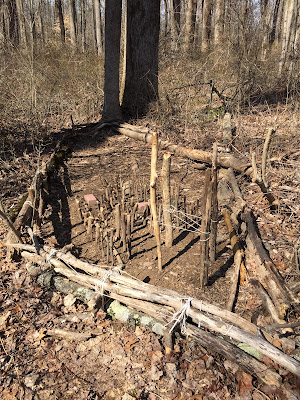Coincidentally, public library staff are talking about doing a reading of the children's book Roxaboxen at the Barden in a month or two.
The boulders along the ridge are rounded, composed of diabase, which in my experience is associated with rare plant species that thrive in the particular kind of soil generated from the weathering of these rocks. The boulders were not deposited here by glaciers, but instead formed from molten upwellings from below. In Herrontown Woods and Autumn Hill Reservation there are numerous little abandoned quarries where some of the larger boulders were split into chunks and hauled away.
Springtime is a great time to figure out where we need more stepping stones along trails. Because the rocks along the ridge are chunky and rounded--of no use for steps through muddy sections of trails--we make frequent trips to rock piles generated nearby, just off the ridge, where a developer has dug a basement. These conveniently flat stones are from the sedimentary deposits that the molten upwellings pushed through to create the ridge.
One plant that doesn't look like much but which I've always been curious about is what is this low-growing grass. I call it soft fescue, and wonder if it was common long ago, and later became the first lawns around houses. Many old lawns still contain this mounded grass. Here's a patch of it growing along Herrontown Road.At Veblen House, the remnants of Elizabeth Veblen's garden still cycle through the seasons, with sweeps of snowbells giving way this week to the many daffodils she spread across the grounds.
The boulders along the ridge are rounded, composed of diabase, which in my experience is associated with rare plant species that thrive in the particular kind of soil generated from the weathering of these rocks. The boulders were not deposited here by glaciers, but instead formed from molten upwellings from below. In Herrontown Woods and Autumn Hill Reservation there are numerous little abandoned quarries where some of the larger boulders were split into chunks and hauled away.












It's nice to read of the black vultures. We saw one a few years ago atop the chimney. It faced us and spread its wings wide, posing for several minutes. If only I'd had my telephoto lens with me!
ReplyDeleteYou have a fine set of pictures from 2017 in the link at "gained respect for them as parents" above.